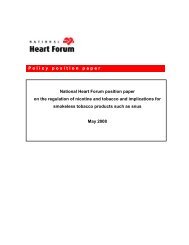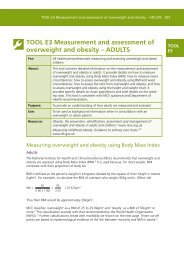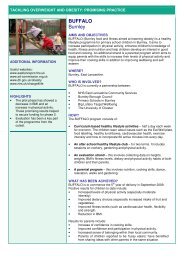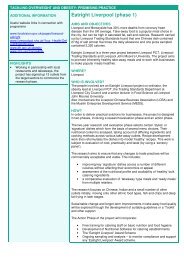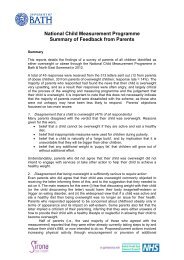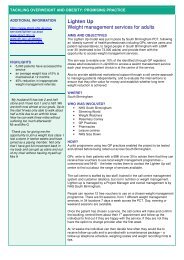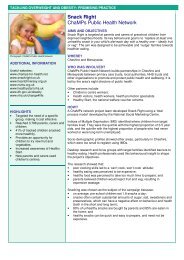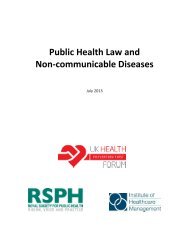The Challenge of Non-Communicable Diseases and Road Traffic ...
The Challenge of Non-Communicable Diseases and Road Traffic ...
The Challenge of Non-Communicable Diseases and Road Traffic ...
You also want an ePaper? Increase the reach of your titles
YUMPU automatically turns print PDFs into web optimized ePapers that Google loves.
An Overview 41<br />
into account [255]. Brazil has used a combination <strong>of</strong><br />
fiscal <strong>and</strong> other legislation to protect <strong>and</strong> improve<br />
its traditional food system: supporting cooperatives<br />
<strong>and</strong> small-scale farmers to produce green vegetables<br />
<strong>and</strong> other fresh foods, <strong>and</strong> helping to protect<br />
<strong>and</strong> stabilize prices <strong>of</strong> healthy staple foods <strong>and</strong> ingredients<br />
so that they become more affordable <strong>and</strong><br />
available [256]. Brazilian children are entitled to one<br />
meal per day at school <strong>and</strong> legislation also requires<br />
that at least 30 percent <strong>of</strong> the national budget for<br />
school lunches be spent on fresh foods from local/<br />
family farms [87].<br />
<strong>The</strong> market for snacks, s<strong>of</strong>t drinks, <strong>and</strong> processed<br />
foods is growing fastest in LMIC, <strong>and</strong> its correlation<br />
with higher tobacco <strong>and</strong> alcohol sales suggests<br />
common industry tactics [257], enabled by rising<br />
incomes <strong>and</strong> weak regulation. Use <strong>of</strong> fiscal pricing<br />
(tax or subsidy) policy instruments have also<br />
been proposed to influence food consumption<br />
patterns to favor the intake <strong>of</strong> healthier, less energy-rich<br />
foods <strong>and</strong> drinks [258]. For prevention<br />
<strong>of</strong> overweight <strong>and</strong> obesity, evidence suggests that<br />
non-trivial pricing interventions could impact on<br />
weight, particularly among children, adolescents,<br />
low socio-economic populations, <strong>and</strong> those most<br />
at risk, but that small taxes or subsidies have little<br />
effect [259-260]. Restricting the promotion <strong>of</strong> energy-rich,<br />
high fat, <strong>and</strong> high sugar foods to young<br />
children through advertising on television or in<br />
schools can be achieved through government-supported<br />
forms <strong>of</strong> self-regulation <strong>and</strong> statutory measures<br />
[261-262].<br />
International efforts could be made to prohibit<br />
the hydrogenation process that generates industrial<br />
saturated fats <strong>and</strong> trans-fats. Governments also need<br />
to mitigate the impact <strong>of</strong> large transnational food<br />
corporations, some <strong>of</strong> which have headquarters<br />
within African nations: for example, many <strong>of</strong> the<br />
South African “Big Food” companies, particularly<br />
the supermarket chains, have invested in other African<br />
nations [263]. For the ultra-processed food <strong>and</strong><br />
drink industries, as with tobacco <strong>and</strong> alcohol, there<br />
is clear evidence that public regulation <strong>and</strong> market<br />
intervention can help prevent the potential harm<br />
caused by ‘unhealthy commodities’, <strong>and</strong> that these<br />
industries should not have a role in national policy<br />
formulation [86].<br />
Physical Activity <strong>and</strong> the Imperative<br />
<strong>of</strong> <strong>Road</strong> Safety<br />
Increased communications about healthy eating <strong>and</strong><br />
physical activity as part <strong>of</strong> programs <strong>of</strong> information<br />
<strong>and</strong> education at the sub-national <strong>and</strong> national levels<br />
could be used to reinforce legislation <strong>and</strong> other interventions.<br />
An important factor is the design <strong>of</strong> urban<br />
environments <strong>and</strong> road <strong>and</strong> transport systems,<br />
which can be influenced to promote or maintain<br />
physical activity.<br />
Keeping people physically active as part <strong>of</strong> daily<br />
living is important for counteracting obesity [264].<br />
A health-supporting <strong>and</strong> safe environment that<br />
facilitates walking <strong>and</strong> cycling can be part <strong>of</strong> a<br />
pro-growth, pro-health, <strong>and</strong> pro-poor transport<br />
strategy, helping increase urban productivity, reduce<br />
poverty, <strong>and</strong> improve health [265]. Only two<br />
SSA countries have national policies that encourage<br />
walking <strong>and</strong>/or cycling as an alternative to car<br />
travel, <strong>and</strong> only 10 SSA countries have national<br />
policies to separate road users as a way <strong>of</strong> protecting<br />
vulnerable road users [61].<br />
As discussed in Box 4, consistent with the goals <strong>of</strong><br />
the 2011-2020 UN Decade <strong>of</strong> Action on <strong>Road</strong> Safety,<br />
a safe <strong>and</strong> efficient road <strong>and</strong> transportation environment<br />
is needed in Africa which gives high priority<br />
to large-scale traffic calming measures, pedestrian<br />
infrastructure, <strong>and</strong> the provision <strong>of</strong> safe transport<br />
space for pedestrians <strong>and</strong> cyclists alongside major<br />
arterial roads [105, 266].<br />
Good <strong>and</strong> safe roads are increasingly seen as a<br />
critical investment for enhancing competitiveness<br />
<strong>and</strong> resilience in Africa. International experience<br />
shows that the most effective <strong>and</strong> sustainable way<br />
to make roads safer is to adopt a “safe system approach”.<br />
<strong>The</strong> good news is that multilateral development<br />
banks, including the World Bank, have<br />
committed to supporting countries in developing<br />
sustainable “safe systems” to prevent road traffic<br />
casualties, including mobilizing more <strong>and</strong> new resources<br />
for road safety [267].<br />
<strong>The</strong> key challenge in most countries in SSA is<br />
to build <strong>and</strong> strengthen institutions <strong>and</strong> capacity<br />
to plan, manage, <strong>and</strong> implement road safety initiatives<br />
at national scale that go well beyond just



